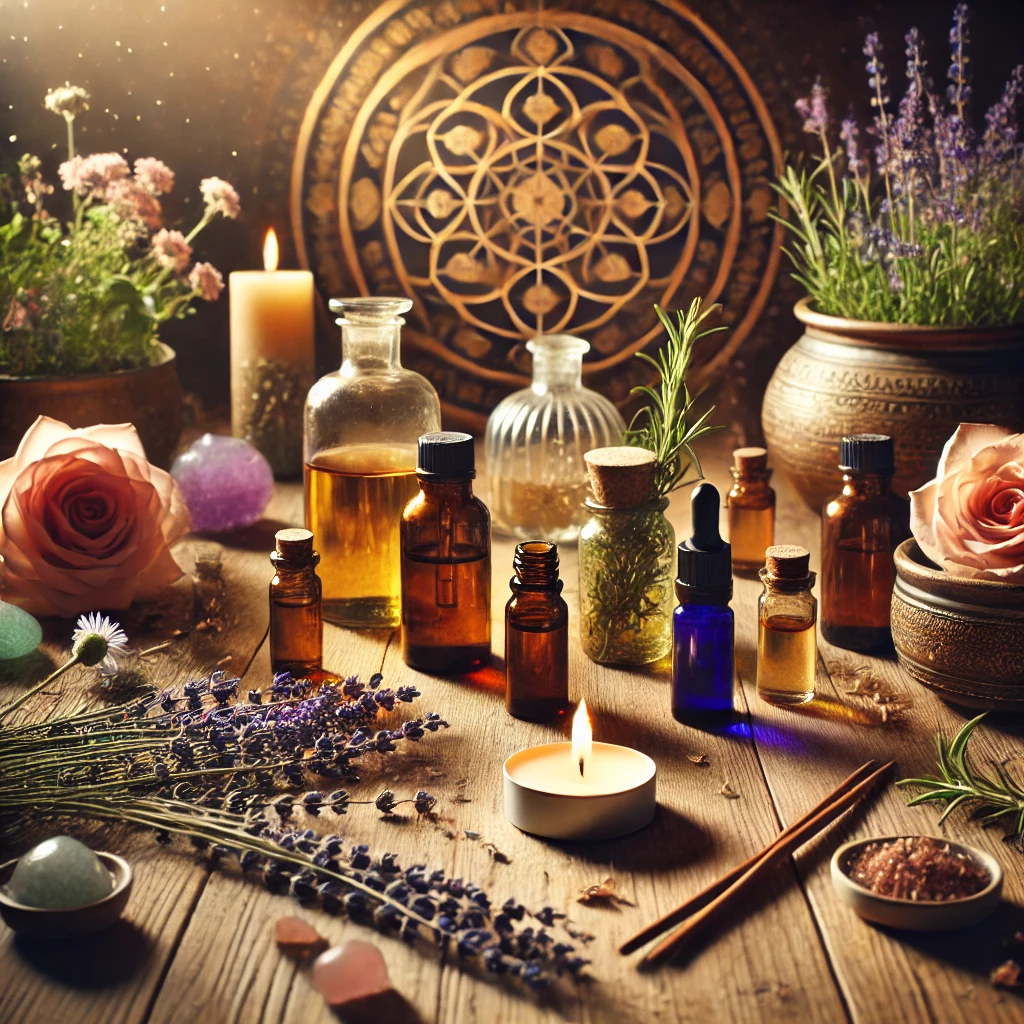Overview
Essential oils are the concentrated, volatile aromatic compounds extracted from the leaves, flowers, bark, roots, and resins of plants. In herbal practice, they serve as powerful tools for physical healing, emotional balance, and spiritual transformation. Used with intention and respect, essential oils offer both immediate effects and long-term therapeutic benefits.
Essential oils are not just fragrances—they are the distilled life force or “soul” of the plant, carrying its vibrational essence and energetic signature. When integrated thoughtfully into herbal protocols, they enhance and extend the healing spectrum from the physical body to the emotional, mental, and energetic planes.
How Essential Oils Work
Essential oils interact with the body through:
- Aromatherapy (inhalation): Rapidly affects the limbic system, impacting mood, memory, and stress response.
- Topical Application: Absorbed through the skin, affecting local tissues and systemic circulation.
- Energetic Field: Subtle effects on aura, chakras, and emotional body through vibration and scent resonance.
Core Benefits in Herbal Practice
| Therapeutic Area | Essential Oil Contribution |
|---|---|
| Immune Support | Antibacterial, antiviral, and antifungal (e.g., tea tree, oregano, eucalyptus) |
| Stress & Anxiety Relief | Calming, harmonizing, and grounding (e.g., lavender, frankincense, neroli) |
| Pain & Inflammation | Analgesic and anti-inflammatory (e.g., peppermint, helichrysum, ginger) |
| Respiratory Health | Decongesting and clearing (e.g., eucalyptus, rosemary, thyme) |
| Digestive Support | Carminative and stimulating (e.g., fennel, peppermint, cardamom) |
| Skin & Wound Healing | Regenerative and antimicrobial (e.g., lavender, chamomile, tea tree) |
| Spiritual Protection & Clarity | Purifying and intuitive (e.g., sage, sandalwood, myrrh, palo santo) |
Spiritual & Energetic Applications
Essential oils are widely used in energy healing, spiritual rituals, and subtle body work, including:
- Chakra Balancing: Using specific oils to clear or activate chakra energy (e.g., rose for the heart, clary sage for third eye)
- Aura Cleansing: Diffusing or spritzing oils like lavender, lemon, or cedarwood to cleanse stagnant energies
- Sacred Space Creation: Using frankincense, sandalwood, or palo santo to set sacred space for meditation or healing
- Dream & Intuition Enhancement: Mugwort, blue lotus, and clary sage can enhance dream recall and psychic vision
- Ritual Anointing: Oils are applied to pulse points, temples, or tools for protection, blessing, or alignment
Common Application Methods
| Method | Purpose & Notes |
|---|---|
| Diffusion/Inhalation | Quick emotional and mental shift; supports respiratory health |
| Massage & Body Oil | Blended with carrier oils for pain relief, emotional support, or grounding |
| Anointing or Pulse Point Use | Ritual use in ceremonies, chakra healing, intention setting |
| Bathing Rituals | Spiritual and physical cleansing; always diluted in carrier or salts |
| Room & Aura Sprays | Mist blends for energetic clearing or mood enhancement |
| Compresses | Applied warm or cold for muscle tension, wounds, or inflammation |
Essential Oil Safety Guidelines
- Dilution Required: Never apply undiluted oils directly to skin (except a few exceptions like lavender or tea tree).
- Avoid Internal Use Without Guidance: Only trained aromatherapists should advise internal use.
- Photosensitivity: Citrus oils (e.g., bergamot, lemon) can cause skin sensitivity in sunlight.
- Pregnancy Caution: Some oils are contraindicated—avoid clary sage, rosemary, basil, etc., unless guided.
- Quality Matters: Use organic, pure, therapeutic-grade oils from reputable sources.
Holistic Integration in Herbal Practice
In holistic herbalism, essential oils are used to enhance the energetic layer of herbal remedies, often in tandem with:
- Herbal teas or tinctures for internal support
- Flower essences for emotional shifts
- Crystals, sound healing, or Reiki for energetic alignment
- Meditation and breathwork for spiritual attunement
They help bridge the physical and energetic realms—especially in trauma recovery, grief, transitions, or spiritual awakenings.
Sacred & Cultural Roots
Essential oils have deep roots in traditional systems:
- Egyptian Rituals: Frankincense and myrrh used in temples and embalming
- Ayurveda: Oils like tulsi, vetiver, and sandalwood are used for doshic balance
- Traditional Chinese Medicine: Aromatic oils influence meridians and Qi flow
- Folk Traditions: Herbalists used infused oils in salves, prayers, and protective charms
Essential oils are not modern inventions—they are ancient allies carried forward into contemporary holistic healing.
Related Subcategories
This entry fits within:
- Herbal Healing Systems
- Aromatherapy & Essential Oils
- Energetic & Elemental Healing
- Rituals & Ceremonial Tools
- Mind-Body-Spirit Therapies
Visual Element Recommendation
Suggested Visuals:
- Infographic: “10 Essential Oils Every Herbalist Should Know”
- Background Image: “Essential Oil Bottles, Crystals, and Flowers on an Herbal Altar”
- Carousel Post: “Essential Oils for Each Chakra: A Vibrational Guide”

